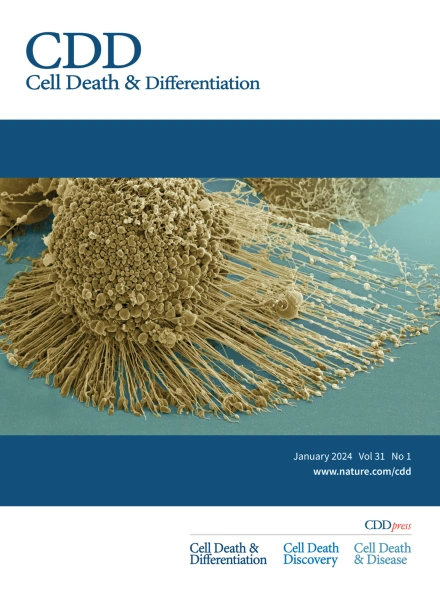The BCL-2 protein family: from discovery to drug development
IF 15.4
1区 生物学
Q1 BIOCHEMISTRY & MOLECULAR BIOLOGY
引用次数: 0
Abstract
The landmark discovery of the BCL-2 gene and then its function marked the identification of inhibition of apoptotic cell death as a crucial novel mechanism driving cancer development and launched the quest to discover the molecular control of apoptosis. This work culminated in the generation of specific inhibitors that are now in clinical use, saving and improving tens of thousands of lives annually. Here, some of the original players of this story, describe the sequence of critical discoveries. The t(14;18) chromosomal translocation, frequently observed in follicular lymphoma, allowed the identification and the cloning of a novel oncogene (BCL-2) juxtaposed to the immunoglobulin heavy chain gene locus (IgH). Of note, BCL-2 acted in a distinct manner as compared to then already known oncogenic proteins like ABL and c-MYC. BCL-2 did not promote cell proliferation but inhibited cell death, as originally shown in growth factor dependent haematopoietic progenitor cell lines (e.g., FDC-P1) and in Eμ-Myc/Eμ-Bcl-2 double transgenic mice. Following a rapid expansion of the BCL-2 protein family, the Abbott Laboratories solved the first structure of BCL-XL and subsequently the BCL-XL/BAK peptide complex, opening the way to understanding the structures of other BCL-2 family members and, finally, to the generation of inhibitors of the different pro-survival BCL-2 proteins, thanks to the efforts of Servier/Norvartis, Genentech/WEHI, AbbVie, Amgen, Prelude and Gilead. Although the BCL-2 inhibitor Venetoclax is in clinical use and inhibitors of BCL-XL and MCL-1 are undergoing clinical trials, several questions remain on whether therapeutic windows can be achieved and what other agents should be used in combination with BH3 mimetics to achieve optimal therapeutic impact for cancer therapy. Finally, the control of the expression of BH3-only proteins and pro-survival BCL-2 family members needs to be better understood as this may identify novel targets for cancer therapy. This story is still not concluded!


BCL-2蛋白家族:从发现到药物开发
BCL-2基因及其功能的里程碑式发现,标志着抑制凋亡细胞死亡是驱动癌症发展的重要新机制,并开启了发现细胞凋亡分子调控的探索。这项工作的最终成果是产生了现在临床使用的特定抑制剂,每年挽救和改善数万人的生命。在这里,这个故事的一些原始参与者描述了关键发现的顺序。滤泡性淋巴瘤中常见的t(14;18)染色体易位使得与免疫球蛋白重链基因位点(IgH)并列的一种新的致癌基因(BCL-2)得以鉴定和克隆。值得注意的是,与ABL和c-MYC等已知的致癌蛋白相比,BCL-2的作用方式截然不同。正如最初在生长因子依赖性造血祖细胞系(如FDC-P1)和Eμ-Myc/Eμ-Bcl-2双转基因小鼠中所显示的那样,BCL-2不促进细胞增殖,但抑制细胞死亡。随着BCL-2蛋白家族的迅速扩大,雅培实验室解决了BCL-XL的第一个结构,随后解决了BCL-XL/BAK肽复合物,为了解其他BCL-2家族成员的结构开辟了道路,并最终在施维雅/诺华、基因泰克/WEHI、艾伯维、安进、序曲和吉利德的努力下,产生了不同促生存BCL-2蛋白的抑制剂。尽管BCL-2抑制剂Venetoclax已投入临床使用,BCL-XL和MCL-1抑制剂也正在进行临床试验,但仍存在一些问题,如是否可以实现治疗窗口,以及应该使用哪些其他药物与BH3模拟物联合使用以获得最佳的癌症治疗效果。最后,BH3-only蛋白和促生存BCL-2家族成员表达的控制需要更好地理解,因为这可能为癌症治疗找到新的靶点。这个故事还没有结束!
本文章由计算机程序翻译,如有差异,请以英文原文为准。
求助全文
约1分钟内获得全文
求助全文
来源期刊

Cell Death and Differentiation
生物-生化与分子生物学
CiteScore
24.70
自引率
1.60%
发文量
181
审稿时长
3 months
期刊介绍:
Mission, vision and values of Cell Death & Differentiation:
To devote itself to scientific excellence in the field of cell biology, molecular biology, and biochemistry of cell death and disease.
To provide a unified forum for scientists and clinical researchers
It is committed to the rapid publication of high quality original papers relating to these subjects, together with topical, usually solicited, reviews, meeting reports, editorial correspondence and occasional commentaries on controversial and scientifically informative issues.
 求助内容:
求助内容: 应助结果提醒方式:
应助结果提醒方式:


